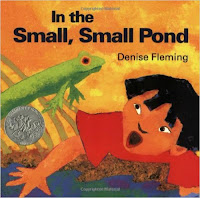Happy Spring everyone! It is raining and chilly in Texas. But just wait, it will be warming up tomorrow. That's how often the weather changes in the Texas Panhandle. As I sit and work on my lessons for the month of April, I realize I keep changing my mind about themes, books and activities as much as the weather is changing. There are so many exciting and wonderful Spring themes, and it can be a little overwhelming to plan thematic units and literacy units for mixed IEP groups, mixed grade levels, and mixed ability level groups.The one theme all my students absolutely LOVE is FROGS. Fiction or Non-fiction, kids (and adults) love frogs.
I want to share with you some of my ideas on using frogs in therapy. There are some amazing books, activities, and media that you can use in your therapy this month, and it's all about FROGS.

In the Small, Small Pond by Denise Fleming is one of two companion books by the same author (In the Tall, Tall Grass) about animals in their habitat.
GOALS TO TARGET USING THIS BOOK:
Rhyming Words-wade/parade, shiver/quiver, doze/close,
lunge/plunge, splatter/scatter, swirl/twirl, swoop/scoop, clack/crack,
dip/flip, etc.
Rich Vocabulary-Tadpole, parade, shiver, doze, heron, scatter,
plunge, claws, pile, breeze
Animal characteristics-tadpoles, geese, heron, dragonfly, turtle,
minnow, water beetle, crayfish, swallow, frog, duck, raccoon, muskrat.
Comparing and Contrasting animals-goose/heron, turtle/frog,
minnow/crayfish, raccoon/muskrat. Use a Venn diagram to identify similarities
and differences between two animals living in the pond.
Story Comprehension-Who, What, Which, When, Where and Why
questions for comprehension can be simple and direct or abstract requiring
perspective and predictions.
Story Elements-This is a great story to elaborate on SETTING. The
setting is the where and when a story takes place. What time of year is it? How
do you know? Where are these animals? What visual and textural evidence does
the story provide that tells the SETTING?
Author's Purpose-Why do you think Denise
Fleming wrote about life near a
pond? Do you think she has experiences of growing up around a pond? Research
the author's website and read her bio.
Perspective-Based on the text and the visual clues from the story,
what do you think the little boy on the cover of the book is thinking? feeling?
saying?
Frog Life Cycle and Frog Facts-students can make illustrations or
models of the frog life cycle.
Shared Writing-Write frog facts and
opinions, draw and illustrate a frog labeling it's body parts, create a bubble
map using adjectives that describe a frog or the character in the story.
In addition to storybooks
and predictable text, there are many frog crafts available to supplement your
lessons on frogs and pond life. The following links are only a small sample.
Below are a few of my favorite authors and
books about FROGS. Expand on the topic and incorporate a variety of text for
your students based on this theme.
Click on the titles below to link to my Teachers Pay Teachers (TPT) Store for more "Froggy" related activities and book companions.
Download my free graphic organizers to use with any book or video.
Lastly, give your students a sensory experience
with a frog-themed sensory tub. Try putting together a sensory bin filled with
small plastic frogs, water, water beads , blue shredded paper,
black beans or split peas for the base, twigs or sticks, cut out Lily Pads,
small shovels and nets, and containers of all sizes to put the frogs in.
I hope you have fun froggin' this month!
Lisa,
SLP
Affiliated Amazon Links are provided for your convenience.
Affiliated Amazon Links are provided for your convenience.





No comments:
Post a Comment